Although window air conditioners are a convenient way of cooling individual rooms, they’re more prone to noise pollution. Luckily, there are numerous solutions for how to deal with a noisy window air conditioner.
This is what I cover in this article. Below, I’ll go over my top suggestions for how to make window air conditioners quieter. First, we’ll give a bit of context and look at what components in a window AC emit noise.
The Sources of Noise in a Window AC
A window air conditioner works like any other refrigeration device: it has a compressor, fans, a condenser and evaporator coils. The system contains a refrigerant, which is converted from a liquid to a gas. In the process, it draws heat out of the air, blowing cool air back into the room.
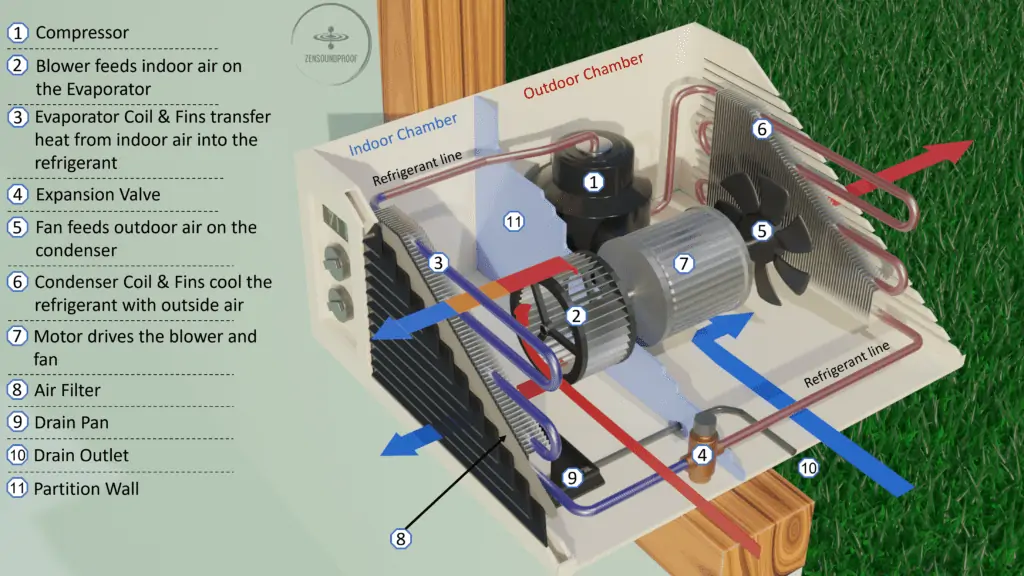
The sources of noise in window units are:
Compressor
Sound type: Impact and Airborne
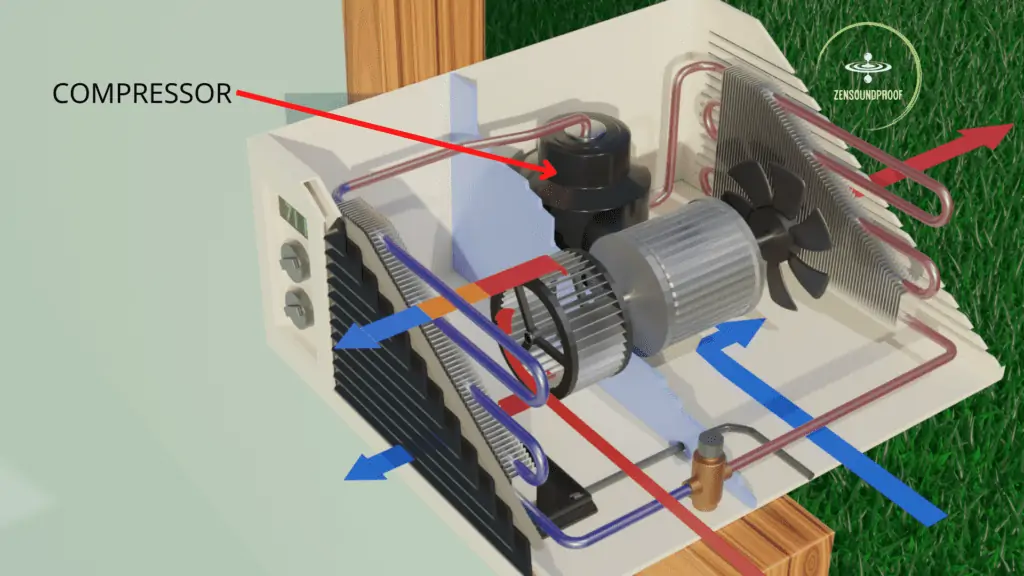
The compressor moves the refrigerant between the condenser and evaporator. To do so, it must put the gas under pressure. As you can imagine, this uses a reasonable amount of energy, and the unit’s motor can create vibrations (impact noise) that pass through the unit into your building’s structure.
In addition to the impact noise, they also emit airborne noise. It means that no matter how well you decouple the compressor from the rest, it’ll still emit noise traveling through the air.
An air conditioning unit will have either an inverter or non-inverter compressor. A non-inverter compressor is either on or off, whereas an inverter is variable speed. Non-inverters create more noise because they only operate at full speed. An inverter can run slower, which creates less noise (and uses less energy).
Fan and Blower
Sound type: Airborne
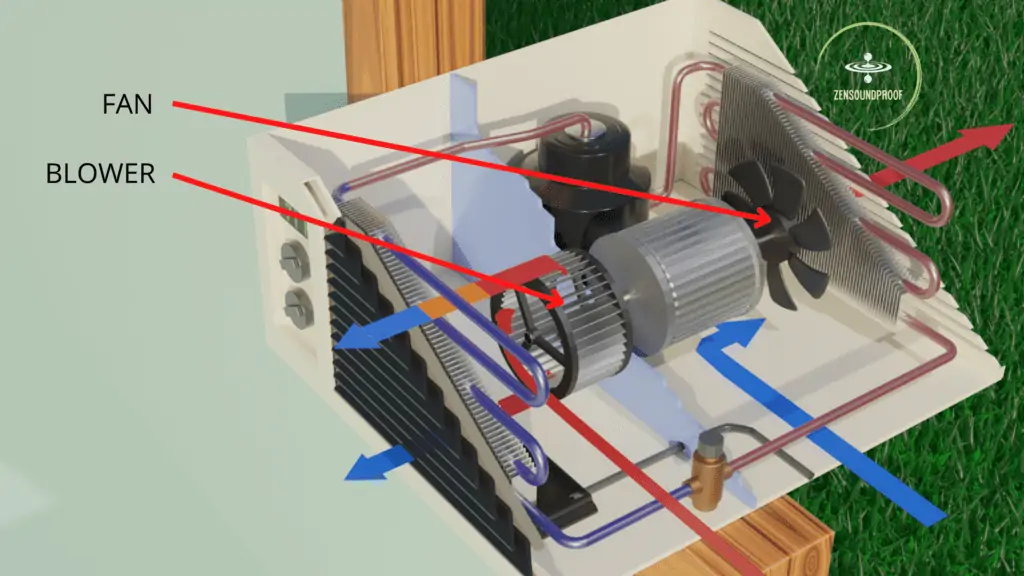
It’ll come as no surprise that fans make noise. Air passing over the fan blades and the blower wheel creates noise, and there’s not loads you can do about this. As with the compressor, a variable speed fan gives you more control over sound emissions.
Motor and Vibrational Unbalance
Sound type: Impact
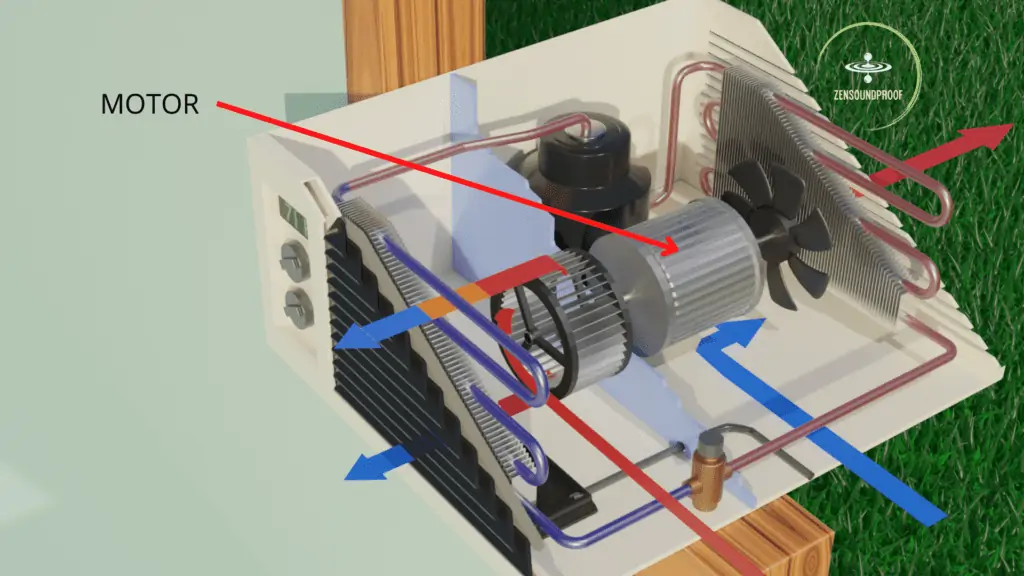
Granted, this isn’t a specific part of the window air conditioner. Many of the components vibrate as they move, which we can classify as “waste” energy. For example, the motor vibrates, and the fans will vibrate more noticeably if they’re unbalanced.
Importantly for our purposes, this vibrational energy passes through the window frame into your building. We can think of it as impact noise, also called structure-borne noise. All sound waves are vibrations, whether these pass through the air or a structure. Those passing through a structure can become sound waves when they leave the structure, though.
For the most part, structure-borne vibrational energy is what we’ll be dealing with below. We will address airborne noise from a window unit, but it’s harder to deal with (and arguably less irritating).
How to Quiet a Noisy Window Air Conditioner
These solutions aren’t in any order, but you may find some are better starting points than others. I’ll point this out where it’s relevant. So, here are my solutions for how to quiet a noisy window air conditioner.
A good place to start is by cleaning your window air conditioner. Here’s a breakdown of the various options you have for cleaning your AC:
1. Clean and Replace the Filter
This is one of the easiest steps, and your AC’s user manual should include instructions on how to do it. The filter is normally easily accessible from the front panel of the AC. Once removed, wash it in soapy water to remove dust build-up, which can cause it to run less efficiently.
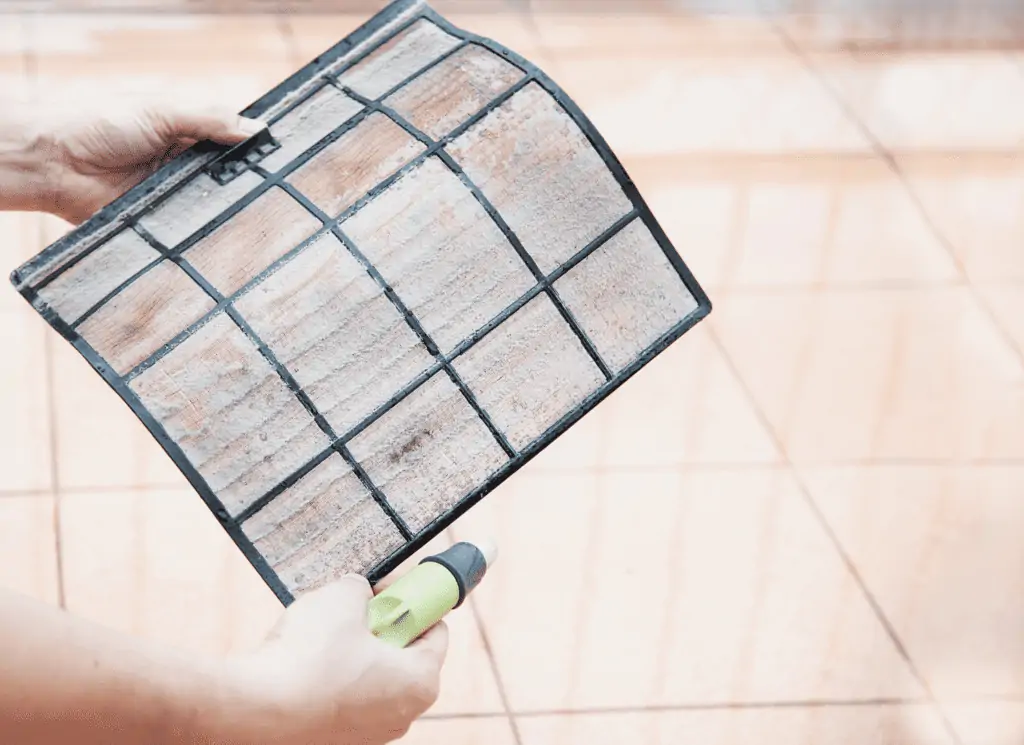
It won’t do any harm to clean the water tray while you’re at it. This won’t impact noise levels directly but is worth doing regularly.
2. Clean the Coils and Fins
The evaporator and condenser coils can get clogged with dust and dirt, which means they don’t transfer heat to the air as efficiently. In turn, your unit could be making more noise simply because it’s working harder.
Unplug the unit. Extract it from the window and leave it in an area where spraying water won’t be a problem. Remove the screws, which should be apparent and easy to access. Lift the top housing and expose the coils. Spray them with a solution of dish soap and warm water. Leave it for a few minutes and then rinse with a garden hose. Put everything back together and turn it back on.
Make sure to not directly spray water on the housing, which contains the electronics. The electronics are located on the front panel generally close to the temperature display.
An alternative, if you don’t fancy taking out your window AC and opening it, is to clean it from the outside without any need to touch it. It doesn’t address the cleaning of the evaporator though. Check out the video below for a quick demonstration.
3. Dust the Fan Blades
It’s the same for the fan blades, providing you can reach them. If you’ve opened up the unit as explained above, your fan is already clean. If not, look for debris caught in the fan through the side grille and remove any dust build-up. If you can reach, dusting them with a cloth will work. However, a compressed air can (such as those used for cleaning computers) will be more effective.
4. Straighten the Fins
Your window air conditioner unit contains evaporator and condenser fins to increase the heat exchange surface between air and the refrigerant.
If you notice any bent fins, straighten them using a fin comb. Bent fins can disrupt the airflow, which can generate more noise and affect the unit’s efficiency. You can check out this video for a quick how-to guide.
5. Lubricate the Shaft and Motor
Although this could fall under the other maintenance tips in point 1, it deserves its own consideration. Over time, the motor’s moving parts wear, which can increase friction and noise output. Of course, this also impacts efficiency, meaning your window air conditioning unit will run for longer.
It shouldn’t be too difficult to do this, provided your user manual has a diagram guide to the unit’s components. You just need to find and expose the fan motor and shaft, which could be as simple as removing the casing and turning the unit on its side.
Then, spray or add a few drops of light lubricant. Your AC manual might suggest a brand or type, but an all-purpose synthetic lubricant should be fine.
6. Fit extra insulation
Your window AC unit should come with side curtain panels that fit it into the window frame. On some models, these will be insulated. But on others, they’re just sheets of plastic. Either way, try securing them in place with some foam weatherstripping (such as this).
This helps dampen vibrational energy before it passes into the window frame. If it’s not too much effort, try fitting some underneath the AC unit, although I have another suggestion for that below.
Some manufacturers include foam strips in their installation. If not, I’d recommend fixing that as it has benefits on acoustic and thermal efficiency as well.
7. Adjust the Position
Correct positioning will help keep your window air conditioner quiet. It essentially boils down to ensuring it’s leveled in the window frame while ensuring there’s no interference between the housing and other hard surfaces of the window sill and sash.
However, some manufacturers suggest installing your window air conditioner at an angle to drain water toward the outside. This doesn’t prevent you from installing it level within the window but involves tilting it slightly pointing out of the window.
Use a spirit level to make sure the window air conditioner is level. If you need to adjust where it sits, weather stripping could work, as could card, or thin foam. Ideally, use something soft to help dampen vibrations.
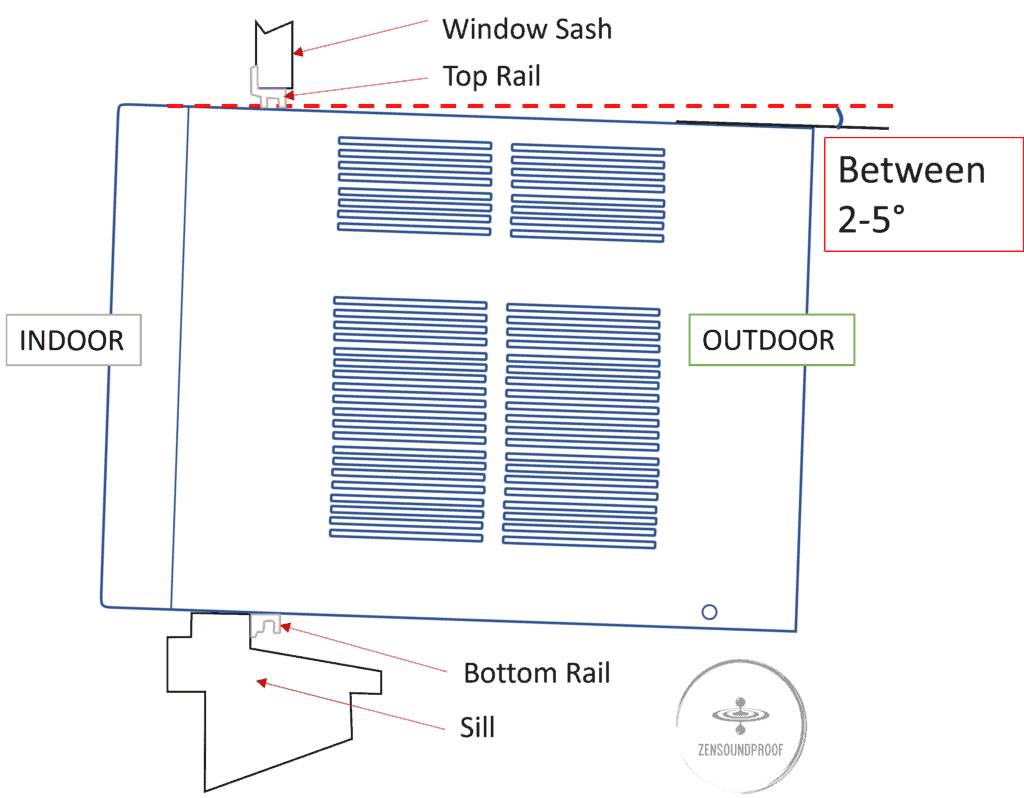
Another option – if you’ve got space in the window – is to add a foam cushion under the unit. You could make it from rigid foam insulation (such as this) or some EVA foam mat. Either will do a good job of dampening vibrations passing into the window frame. Also, you can use it to level the AC as it sits on the windowsill.
8. Tighten everything up
This is another no-brainer in terms of maintenance. Over time, vibrational energy can cause screws to come loose, which then means parts can rattle more. You should try tightening screws and components at the beginning of summer before you use the unit properly.
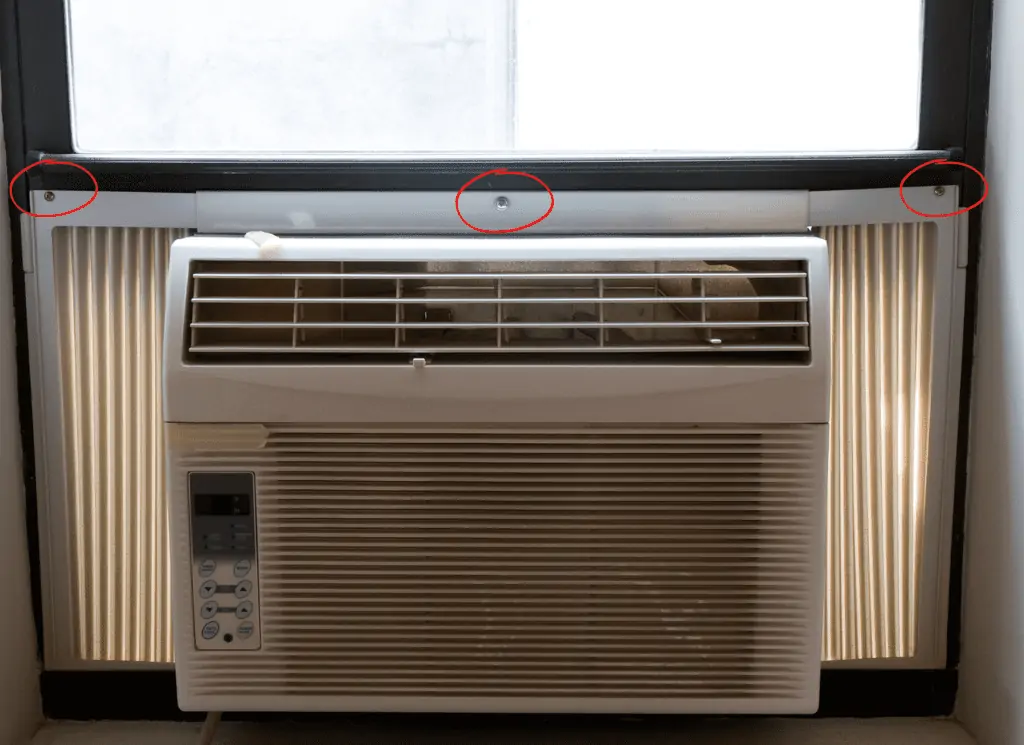
If you’re comfortable opening the unit, make sure you check the fan blades are tight. On the outside level, pay attention to housing and support screws. Don’t overtighten them, but just make sure nothing is loose.
Why Soundproofing Your Window Frame is Important
When you have a window air conditioner fitted, your window’s sound-blocking ability is compromised. Granted, it’s not amazing in the first place, but even a single-glazed window is better than an open one. There are some ways you can mitigate this, including:
1. Adding insulation
The panels surrounding your window air conditioner will, at the very least, be sheets of plastic. These offer basically nothing in terms of sound blocking, but you can help this by installing some insulation. Adding an extra layer will help muffle incoming noises.
Foam cavity wall insulation should be fine, as you’ll want a lightweight product. Simply cut the foam to size and glue it to the plastic panels. At a minimum, install it indoors, but you could stick some to the outer side too. But be wary that an outside installation might not hold up well against varying weather conditions.
2. Add putty
Another thing to consider is the window itself vibrating. You can address this by resealing it with window putty or using seal tape. In theory, you need to completely remove the window for this, but a good compromise is to seal any cracks or gaps you see around the window frame.
Alternatively, you could do the same job with Green Glue noiseproofing sealant. It’s an acoustic sealant that remains flexible over time, unlike traditional caulks that harden quickly and increase the risk of gaps appearing.
When to Upgrade to a Quiet Window AC
Although we can spend as much time and money as we want trying to make a noisy window air conditioner quieter, sometimes it’s just not worth the effort. In these situations, it’s usually a more sensible option to take the financial hit and buy a new window air conditioner.
A standard window air conditioner will sit around 65dB, but anything between 40dB and 55dB is good for a quiet window air conditioner. If you’d like some more information, check out my article on the best quiet window air conditioners.
Here’s a list of scenarios where it’ll make sense to upgrade your loud window air conditioner to a quieter one.
Energy Efficiency
A unit’s energy efficiency can have an impact on its noise levels. Factors such as inverter technology and age are important, as an older unit will make more noise and be less efficient simply because of its age.
Also, a newer, Energy Star certified model is more likely to have an inverter compressor. This can help reduce overall sound levels (and your electricity bill).
If you do so, I’d advise comparing the SEER of your current model with recent models (around 12-13). By doing so, you can deduct the amount saved per year, thus finding out how quickly you’ll recover the purchase expense.
Maintenance Issues
Even if you regularly maintain your window air conditioner, various issues can lead to unpleasant noises. Some are normal (such as popping and clicking), but others like screeching or loud rattling can be signs of bigger problems.
While you could get it repaired, this is often a good enough sign to get a new unit. If nothing else, they’ll come with a warranty, meaning you could get these issues repaired for free in a certain timeframe.
It’s Outlived its Use
The industry standard lifespan of a high quality air conditioner is about 10 years. Your unit might still be functional after this time, but advances in technology mean that newer units will generally just be better.
Importantly, it’ll affect energy efficiency and, usually, noise levels. If your unit keeps breaking, its air quality isn’t great, or you’ve noticed it’s sucking up more energy, it might be time to get a new unit.
Final Thoughts on Quietening Window Air Conditioners
I hope these tips will help you make your window air conditioner quieter. It can be a fun DIY project to address the issues, as most are fairly easy to solve.
Of course, if you haven’t had any luck, consider opting for a new model or calling in a professional to check out your current unit.
Do you have any other tips for dealing with noise from a window AC? Let me know in the comments below.
